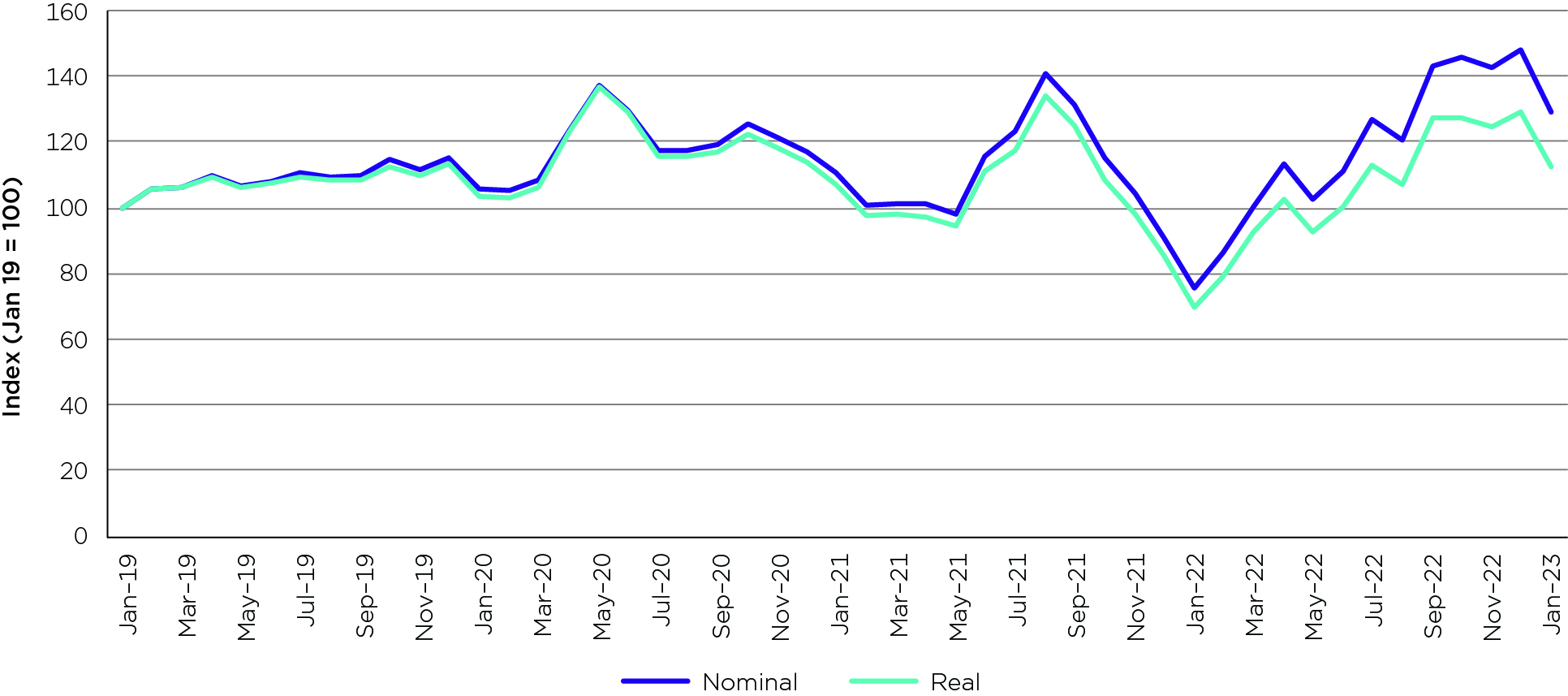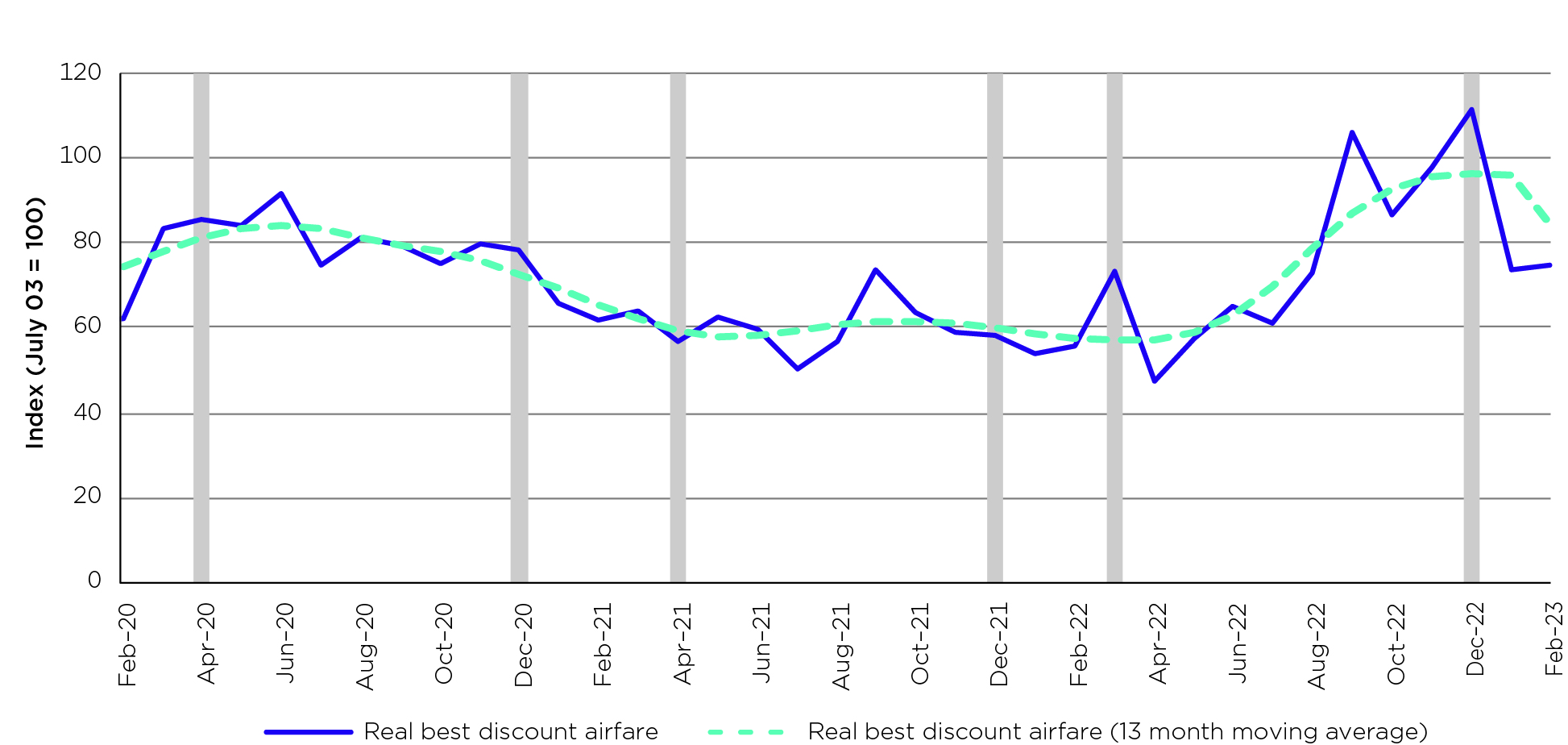Domestic airfares have declined from historic highs at the end of 2022; however, they remain above 2019 prices, the ACCC's latest Airline Competition in Australia report reveals.
The quarterly report, released today, shows that after hitting a 15-year high in December 2022, the price of discount fares decreased by a third in real terms in January 2023.
Average revenue per passenger, which represents average prices across all fare types, declined by 13 per cent in real terms between December 2022 and January 2023. Despite the falls, average revenue per passenger remained 13 per cent higher in real terms (29 per cent in nominal terms) than it was in 2019.
"While it's positive to see airfares fall from record highs in 2022, passengers are still generally paying more to fly today than they were before the pandemic," ACCC Commissioner Anna Brakey said.
"Airfares typically come down after the Christmas travel peak due to a seasonal decrease in demand, however some of this reduction is also explained by the airlines increasing their seat capacity."
The industry made 5.9 million seats available for travel in January 2023, the highest in more than six months. Qantas flew at 102 per cent of its pre-pandemic capacity, Virgin at 96 per cent and Jetstar at 84 per cent.
The price of jet fuel has fallen recently after peaking in mid-2022 due to the war in Ukraine. The price was 35 per cent lower in real terms at the end of February 2023 than it was in June 2022.
"The price of jet fuel has been trending down which should enable airlines to reduce airfares further in coming months," Ms Brakey said.
While airlines increased capacity, this did not result in more passengers flying. In January, 4.4 million passengers flew within Australia, which is 89 per cent of pre-pandemic levels. Higher capacity and a seasonal reduction in demand resulted in more empty seats, leading to a fall in the industry load factor from 83 per cent in October 2022 to 75 per cent in January 2023.
The airlines' on-time performance improved in January 2023. The industry reported 23.9 per cent of flights arrived late in January. Most airlines have improved their delay and cancellation rates over the last few months. Jetstar's performance was relatively poorer, reporting the highest rate of delayed (34.6 per cent) and cancelled (7.3 per cent) flights in January.
"The airlines generally managed to increase their levels of flying without significantly compromising their on-time performance," Ms Brakey said.
"After extensive operational challenges for much of 2022, most airlines appear to be getting closer to their pre-pandemic capability."
In late January low-cost carrier Bonza became the first high-capacity passenger airline to enter the domestic market in 15 years. Bonza is predominantly operating on previously unserved routes that connect regional centres to holiday destinations, allowing passengers to travel directly rather than via a major city.
Bonza's network covers 27 routes across Queensland, New South Wales and Victoria.
"Bonza's entry to the domestic market provides increased route choice which is good news for Australian consumers," Ms Brakey said.
"The new budget airline will provide travellers on the east coast of Australia with new and direct connections, as well as competition on certain routes."
Jetstar transported 26.9 per cent of all domestic passengers in January 2023, an increase of nearly four percentage points from the last quarter. The budget carrier typically records an increase at this time of year when people are increasingly flying for leisure rather than business. Qantas' market share fell to 34.8 per cent and Virgin Australia had a market share of 33.4 per cent. Rex flew 4.9 per cent of all domestic passengers.
The ACCC's report is the 11th and penultimate report under the direction from the Australian Government to monitor prices, costs and profits in domestic air passenger services. The direction expires in June 2023.
Index of average fare revenue per passenger across all routes - January 2019 to January 2023

Source: ACCC calculations using data from the ABS and data collected by the ACCC from Qantas, Jetstar, Virgin Australia and Rex.
Note: The average revenue per passenger includes both economy and business fare revenue. It excludes ancillaries and Tigerair data. Data has been adjusted for inflation using the latest ABS CPI quarterly data up to December 2022.
Price index of discount economy airfares weighted across 70 busiest domestic routes - February 2020 to February 2023

Source: The Bureau of Infrastructure and Transport Economics (BITRE) Domestic Air Fares (Best Discount) index (cheapest available economy airfares).
Note: Grey bars indicate December and Easter holiday periods. Airfares recorded April 2021-February 2022 may be impacted by the government's half-price ticket program (TANS).
Background
On 19 June 2020, the ACCC was directed by the then Treasurer to monitor the prices, costs and profits of Australia's domestic airline industry and provide quarterly reports to inform Government policy. The direction expires in June 2023.






